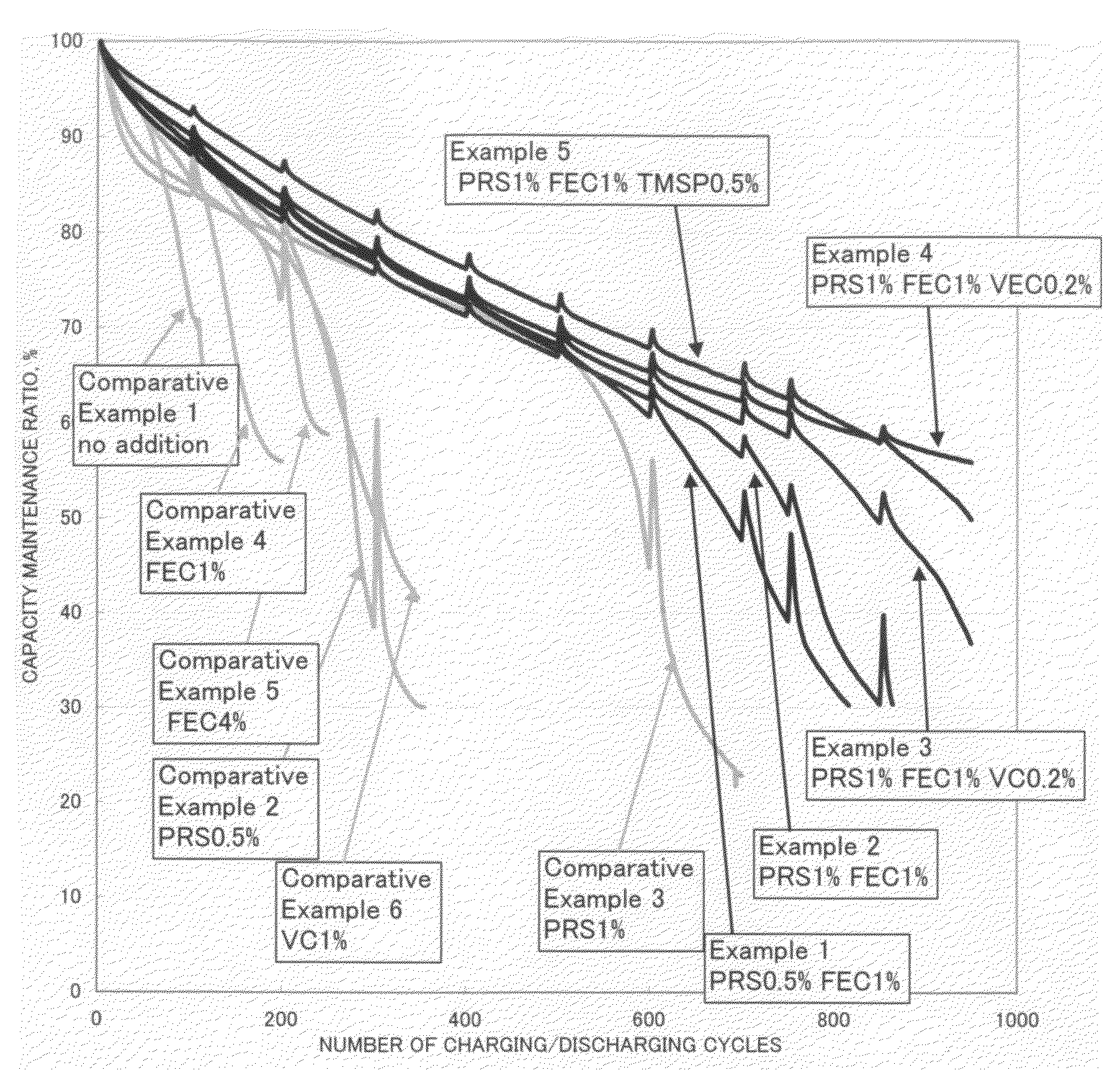Nonaqueous Electrolyte Solution and Lithium Secondary Battery Using Same
a technology of nonaqueous electrolyte and lithium secondary batteries, which is applied in the direction of non-aqueous electrolyte cells, cell components, electrochemical generators, etc., can solve the problems of lowering the operating life of the battery, requiring an operating life of several years or longer, and increasing the internal resistance of the battery, etc., to achieve excellent charge/discharge cycle characteristics, longer operating life, and high capacity
- Summary
- Abstract
- Description
- Claims
- Application Information
AI Technical Summary
Benefits of technology
Problems solved by technology
Method used
Image
Examples
example 1
Preparation of a Nonaqueous Electrolyte Solution
[0079]Ethylene carbonate (EC) and ethyl methyl carbonate (EMC) were mixed at a ratio of 4:6 (weight ratio) to form a nonaqueous solvent, LiPF6 as an electrolyte was dissolved therein, and the concentration of the electrolyte was adjusted to 1 mol / l. To this solution, 1,3-prop-1-ene sultone as a sultone compound, and 4-fluoroethylene carbonate as an ethylene carbonate having a hydrogen atom substituted by a fluorine atom were added so that the contents thereof were adjusted to 0.5 weight % and 1 weight %, respectively, with respect to the total amount of the nonaqueous electrolyte solution.
[0080]
[0081]20 parts by weight of artificial graphite (SFG6, manufactured by TIMCAL), 80 parts by weight of natural graphite-based graphite (GDR, manufactured by MITSUI MINING CO., LTD.), 1 part by weight of carboxymethylcellulose and 2 parts by weight of SBR latex were formed into a paste with a water medium, and the paste was kneaded to prepare a ne...
example 2
[0088]A testing battery was obtained in the same way as in Example 1, except that the contents of 1,3-prop-1-ene sultone and 4-fluoroethylene carbonate were adjusted to 1 weight %, respectively, with respect to the total amount of the nonaqueous electrolyte solution. Evaluations of the load characteristics test 1 and the charge / discharge cycle characteristics at high temperature of the obtained testing battery were conducted.
example 3
[0089]A testing battery was obtained in the same way as in Example 1, except that 0.2 weight % of vinylene carbonate was contained, in addition to 1 weight % of 1,3-prop-1-ene sultone and 1 weight % of 4-fluoroethylene carbonate, with respect to the total amount of the nonaqueous electrolyte solution. Evaluation of the charge / discharge cycle characteristics at high temperature of the obtained testing battery was performed.
PUM
 Login to View More
Login to View More Abstract
Description
Claims
Application Information
 Login to View More
Login to View More - R&D
- Intellectual Property
- Life Sciences
- Materials
- Tech Scout
- Unparalleled Data Quality
- Higher Quality Content
- 60% Fewer Hallucinations
Browse by: Latest US Patents, China's latest patents, Technical Efficacy Thesaurus, Application Domain, Technology Topic, Popular Technical Reports.
© 2025 PatSnap. All rights reserved.Legal|Privacy policy|Modern Slavery Act Transparency Statement|Sitemap|About US| Contact US: help@patsnap.com



